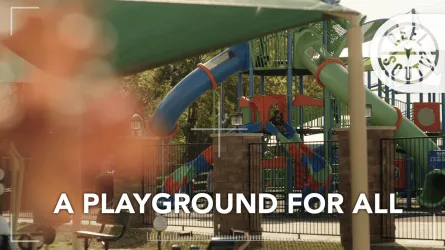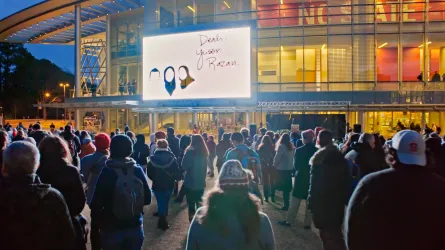The newest Reel South short film, A Family That Steals Dogs, from artist, animator, and filmmaker John C. Kelley, calls us to that familiar interior monologue of family misgivings and questions that surface when grief takes a firmer root in the daily conscience. In this intricate and deft animated story, Kelley’s self-recorded voice embodies the hauntings that reveal themselves to him after the death of his brother.
After the Reel South short premiere, which you can watch here, Reel South digital producer, Heather Leighton, caught up with him about the film and its creation. The interview below has been edited for clarity and length.
Heather: We have a few ideas about what inspired your short, but can you go into more detail about the inspiration and the moment you decided to make it?
John: I knew the title of the film before I knew what it was going to be about. At the time, I knew about the dogs and thought it might be a short story. My first plan was something chaptered by specific dogs that told dark little anecdotes that coincided with each dog’s appearance. Of course, all of this changed with my brother’s passing. After that, I wasn’t really sure what to do – creatively or otherwise. There was a period of probably a year spent moping around my studio and compulsively rearranging the furniture.
At the same time, my animated short GUSTER was in its festival run, so I did a little traveling and a lot of thinking – just about the grieving experience overall. I noticed these desperate, uncanny moments that strung it together. I think it was during that time that the story started to come together.
After that, the sound and field recording really got the project going; just sorting through all of the recordings from the cabin, my audio diary and things like that.
Heather: What do you hope the Reel South audience will learn from your short?
John: That’s a tough one. I’m not sure. I attended (and hid in the back of) a Jungian analysis of my film earlier this year, and discovered that people are learning things from the film that I am very much unaware of. There are some themes, though, that I hope viewers notice.
There were efforts made in the editing to prevent it from being too didactic, but one thing that I come back to a few times in the film is the idea of a familial trait; some kind of common element or behavior or appearance that signifies a special bond. This doesn’t exclusively apply to a biological family either - it’s more inclusive than that – but in this case it was about searching for that connection with someone who had been lost, literally or figuratively. Something that could connect or reconnect me to my brother across the schism of death, when our living relationship had been complicated by my feeling of otherness. The film supposes the trait that binds me to my brother is stealing dogs – again, literally or figuratively.
Since making the film, I’ve really loved reading Joan Didion – particularly her notebooks – and she did some writing about “the South”; driving through and staying in hotels, and seeing the whole thing with a poetic distance and critical objectivity that I don’t think I’m capable of as an Arkansan. All of my thoughts on the area are extremely subjective and rooted in my memory and experiences, which took place across 40 years and have blurred with a lot of TV and movies. And so I am often wondering if what I see is real – if it means what I think it means. The film is rooted in this kind of questioning, and grief allows this other category of belief, or maybe hope. Hoping there is meaning in the window opening, or in the dogs on the highway. No doubt, it is “magical thinking”.
Heather: How did your creative process during this short differ from previous projects? How was it the same?
John: For this film, I worked alone. Partially because it was such a personal story, I wanted to be in touch with all aspects of it, but it also allowed the film to take shape very organically. The sound, animation and story were all coming together at the same time rather than in a traditional workflow – some images would inspire sounds, which would then inspire sections of the narrative, etc. Being able to hop between recording dialogue, designing the sound and animating really made it an exciting, somewhat unpredictable process. In the end I had more than I needed – I cut a lot out and tried to keep it very skeletal to maintain a state of formal collapse that echoed the collapse in the film.
Heather: How did the creation of the film help you?
John: It certainly gave me some clarity – but also, I was working on it during the beginning of the pandemic. Suddenly we were all sent home and there was no real plan or idea of how the future was going to look, so having a project to work on was good for me. It kept me occupied, and gave me some structure during that weird stretch where we didn’t really know what we were up against.
Heather: What was the most difficult part of creating the film?
John: I think that making is generally difficult for me. Especially writing – it takes me forever, and I have to try really hard. There are some extremely gifted filmmakers and writers out there, but for me there is nothing effortless about this stuff.
Truth be told, I was pretty conflicted about making it at all. Writing these experiences into a nice little narrative package put me in some weird meta-spectator place that didn’t feel good – I didn’t like the optics of it; that I was an ambulance chaser and the ambulance.
Heather: What did you learn as you were creating it?
John: I think I was reminded how crucial music and sound design is to my practice. The audio is the bedrock that everything else gets built on top of. I was especially guided by the recordings of rain from the cabin. Listening back to those was eerie. Some music used in the film was also recorded in the cabin and reprocessed later to become more of a texture, so there was a raw, honest space where those sounds came from.
Heather: What is next for you as a creator? Anything to brag about?
John: I have a few things in the works – I’m putting together another short film made from some stories that relate a bit to A Family that Steals Dogs. I guess it’s a companion piece. It’s coming along, but slowly. The music is done, but the rest is taking its time. I’ve finally settled into working from home now, and the rhythm is so different. There is a natural buzzing panic in my studio at the University. Everything is done quickly there, but frenzied; buckets of coffee, thousands of emails. Home is nice right now – I have a window and a cat that visits me a few times a day.
Apart from that, I’m working on a few projects with actual people – some music for film, a music video, and an animated series; all still very early in the process.
Category
Share


